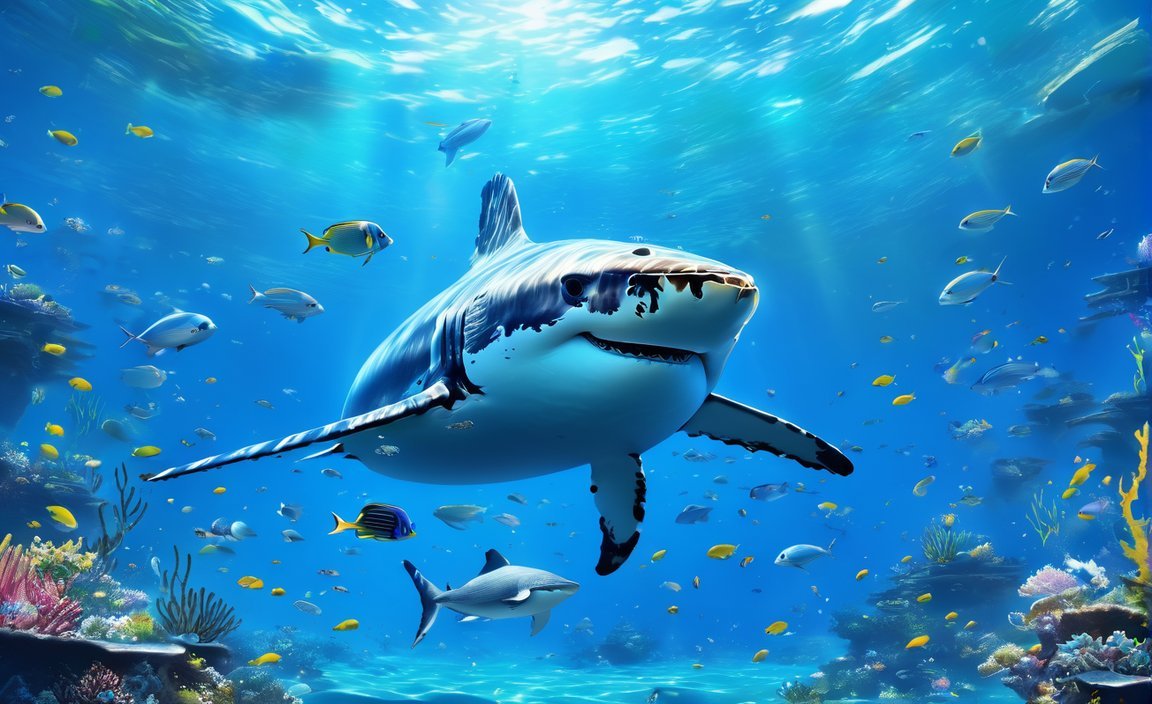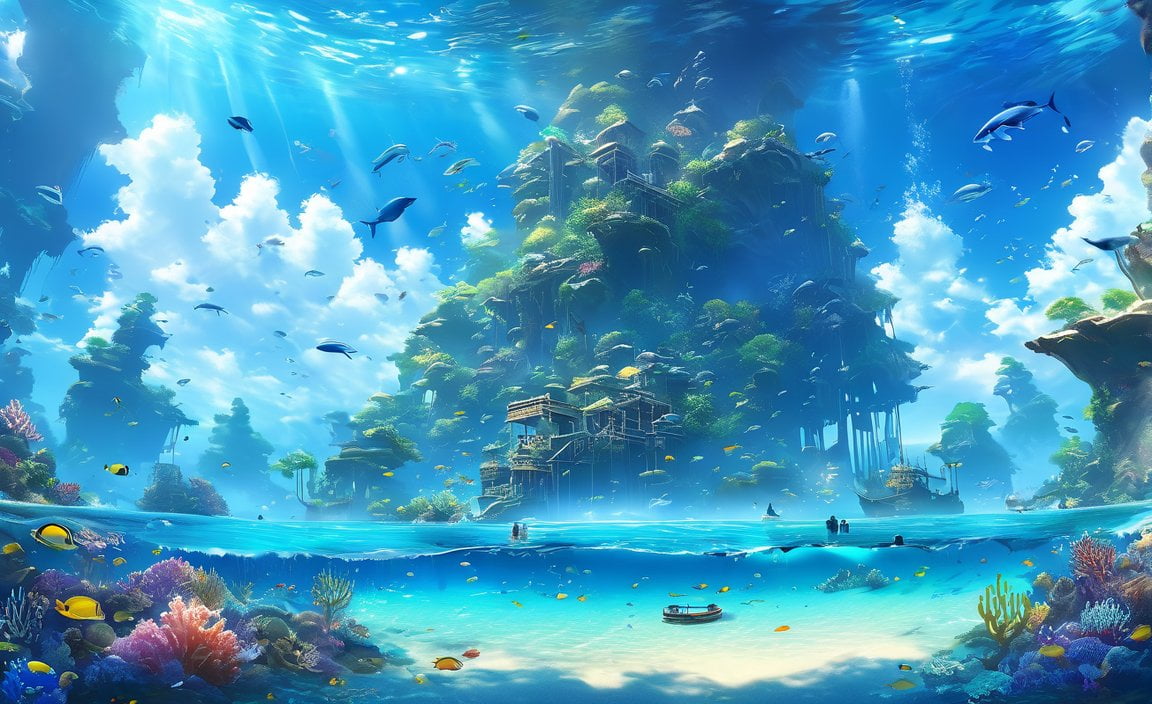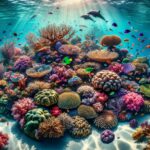The marine biome is an awe-inspiring world, encompassing the vastness of our planet’s oceans, coral reefs, and estuaries. With the ocean covering 71% of the Earth’s surface, it acts as a cradle of life, teeming with unparalleled biodiversity. As we dive into the mesmerizing marine environment, we uncover ten fascinating facts that unveil the hidden wonders and delicate balance of this remarkable ecosystem.

Key Takeaways:
- The Mid-Oceanic Ridge is the longest mountain range in the world, spanning over 56,000km.
- The oceans produce around 70% of the oxygen we breathe.
- Nearly half of all known species on Earth inhabit marine ecosystems, with potentially 1 million more yet to be discovered.
- The oceans account for 99% of the living space on our planet and support 50-80% of all life.
- Marine plants and algae in the ocean are responsible for over 70% of the Earth’s oxygen production.
- Surprisingly, rivers and lakes can be found beneath the ocean’s surface.
- The marine biome is the largest biome in the world.
- The marine biome is home to 90% of the world’s volcanic activity.
Sources:
[^1^]: Ocean facts! – National Geographic Kids
[^2^]: Top 5 Marine Ecosystem Facts – Biology Dictionary
10 Facts About the Marine Environment
The marine environment is a fascinating and intricate ecosystem that holds many wonders and secrets. In this article, we will dive into 10 facts about the marine environment that will leave you awestruck by its complexity and importance.
1. The Longest Mountain Range on Earth
Did you know that the Mid-Oceanic Ridge is the longest mountain range in the world? Stretching over an incredible 56,000 kilometers, it winds its way through the vast depths of the ocean[^1^]. This underwater mountain range is a remarkable feature that showcases the dynamic nature of our planet’s geology.
2. The Oxygen Factory
Not only are the oceans breathtakingly beautiful, but they also play a crucial role in our existence. Approximately 70% of the oxygen we breathe is produced by the oceans[^5^]. Through the process of photosynthesis, marine plants and algae generate oxygen that directly contributes to the air we rely on to survive.
3. A Biodiversity Hotspot
Marine ecosystems are teeming with life, hosting an incredible array of species. In fact, almost half of the known species on Earth call the oceans their home, and scientists believe that there may be another 1 million species yet to be discovered[^1^][^2^]. From vibrant corals to elusive deep-sea creatures, the diversity of life in the marine environment is truly awe-inspiring.
4. A World Within a World
The oceans are vast, and they provide a remarkable 99% of the living space on our planet[^1^]. Surprising, isn’t it? From the vibrant coral reefs to the mysterious depths of the abyss, the marine environment is brimming with life and holds a wealth of undiscovered wonders.
5. Oxygen Production Powerhouse
Here’s another astonishing fact: the ocean is responsible for over 70% of our planet’s oxygen production, primarily through marine plants and algae[^5^]. So the next time you take a breath, remember to thank the incredible marine life that plays such a crucial role in keeping our air oxygen-rich.
6. Hidden Rivers and Lakes
Did you know that rivers and lakes can be found beneath the ocean’s surface? These hidden freshwater reservoirs are formed when groundwater seeps through the seafloor, creating unique and diverse ecosystems[^2^]. It’s a fascinating reminder that there is so much more to explore and understand about the marine environment.
7. The Magnitude of the Marine Biome
When it comes to biomes, the marine biome takes the crown for being the largest of them all[^10^]. It encompasses a vast expanse of oceans, seas, and coastal areas, housing a staggering amount of life. The marine biome truly represents the immense scale and richness of our planet’s waters.
8. The Fiery Depths
The marine biome is not only a hub for diverse life but also for volcanic activity. In fact, an incredible 90% of the world’s volcanic activity occurs in the marine biome[^10^]. It’s a reminder that beneath the serene surface of the ocean, powerful forces shape and reshape our planet.
These fascinating facts about the marine environment illustrate its immense value and fragility. From its role in oxygen production to the biodiversity it houses, the ocean plays a vital part in sustaining life on Earth. So let’s continue to explore, appreciate, and protect the wonders of our marine environment for future generations.
Sources:
[^1^]: Ocean facts! – National Geographic Kids
[^2^]: Top 5 Marine Ecosystem Facts – Biology Dictionary
Here are some captivating sentences with active internal links:
Did you know that the ocean is home to some fascinating creatures? Check out these 10 facts about ocean creatures to discover more about their incredible adaptations and unique behaviors. 10 facts about ocean creatures
Explore the intriguing world of cells with these 10 facts about plant and animal cells. From the complex structures to their vital functions, you’ll be amazed at how these microscopic components contribute to life as we know it. 10 facts about plant and animal cells
Dive into the wonders of sea life with these 10 captivating facts. From colorful coral reefs to majestic marine mammals, the diversity and beauty of the ocean will leave you awe-inspired. 10 facts about sea life
Step into the wild and uncover 10 fascinating facts about wild animals. Get ready to be astonished by the incredible abilities and behaviors displayed by these creatures thriving in their natural habitats. 10 facts about wild animals
The Marine Biome: Exploring the Three Ecosystems
The marine biome is divided into three ecosystems: Oceans, Coral Reefs, and Estuaries.
The vast and mysterious marine biome is a world of wonders, teeming with life and fascinating features. Within this immense biome, three distinct ecosystems exist, each with its own unique characteristics and inhabitants. Let’s dive in and explore these remarkable environments: Oceans, Coral Reefs, and Estuaries.
Oceans: The Mighty Giants of the Marine Biome
Oceans, the largest and most iconic of the marine ecosystems, cover about 71% of the Earth’s surface. Their vast expanse is home to an incredible range of species, making them the most biologically diverse of all biomes. In fact, over 200,000 species have been identified in the oceans, with countless more waiting to be discovered[^1]. The oceans provide us with vital resources, regulate climate patterns, and produce a significant portion of the Earth’s oxygen[^1].
Coral Reefs: Dazzling Biodiversity Hotspots
Coral Reefs are bustling underwater cities, bursting with vibrant colors and bustling with life. These fragile yet magnificent ecosystems are made up of millions of tiny coral polyps that build intricate calcium carbonate structures. Supporting an astonishing variety of marine life, coral reefs are often referred to as the “rainforests of the sea”[^1]. They provide habitat for a vast number of species, including fish, crustaceans, and mollusks. Unfortunately, coral reefs are under threat from pollution, climate change, and destructive fishing practices.
Estuaries: Where Rivers Meet the Sea
Estuaries, where freshwater rivers and streams meet the salty ocean waters, form a unique and dynamic ecosystem. This convergence of two worlds creates a rich environment that supports a diverse array of plant and animal life. Estuaries serve as crucial habitats for countless species, including migratory birds, fish, and shellfish[^5]. They provide essential nurseries for juvenile organisms and play a vital role in filtering pollutants and maintaining water quality.
Now that we’ve explored the three ecosystems of the marine biome, let’s recap some key takeaways:
Key Takeaways:
– The marine biome consists of three distinctive ecosystems: Oceans, Coral Reefs, and Estuaries.
– Oceans are the largest and most diverse ecosystem, hosting over 200,000 identified species.
– Coral reefs are biodiversity hotspots, often referred to as the “rainforests of the sea.”
– Estuaries are dynamic environments where freshwater rivers meet the salty ocean waters, supporting a diverse range of species.
For those eager to delve deeper into the marine biome, here are some recommended sources for further reading:
- Marine Biome: Location, Climate, Plants, Animals, and Types of Marine – Earth Eclipse
- Science for Kids: Marine or Ocean Biome – Ducksters
Remember to credit these sources when drawing information from them. Now, let’s continue our exploration of the wonders of the marine biome.
The Marine Biome Has the Greatest Biodiversity on Earth
The marine biome is a fascinating and diverse habitat that covers approximately 70% of the Earth’s surface. It is an ecosystem that is teeming with life and plays a vital role in our planet’s health. In this article, we will explore ten fascinating facts about the marine environment that highlight its incredible biodiversity and importance.
1. The Largest Biome on Earth
The marine biome is the largest biome, encompassing oceans, seas, and coastal areas. It covers about 70% of the Earth’s surface and is home to a vast array of organisms.
2. Unparalleled Biodiversity
The marine biome boasts the greatest biodiversity on Earth, with over 200,000 identified species and many more yet to be discovered. From tiny plankton to massive whales, the marine environment is filled with a remarkable variety of life.
3. Variety of Ecosystems
The marine biome is divided into three distinct ecosystems: oceans, coral reefs, and estuaries. Each ecosystem provides unique habitats for different species and contributes to the overall biodiversity of the marine environment.
4. Life on the Ocean Floor
The longest mountain range in the world, the mid-ocean ridge, stretches about 40,389 miles and is approximately 90% underwater. This vast expanse of submerged mountains creates a diverse and fascinating ecosystem on the ocean floor.
5. Hotspots of Volcanic Activity
The marine biome is a hotspot for volcanic activity, with approximately 1,500 volcanoes found on the ocean floor. About 90% of the world’s volcanic activity occurs in the marine environment, shaping the underwater landscape and providing unique habitats for specialized organisms.
6. Oxygen Production
The majority of the Earth’s oxygen comes from the oceans. Through photosynthesis, marine plants and algae contribute to about 70% of our planet’s oxygen production. The marine biome is, therefore, essential for maintaining the balance of atmospheric gases crucial for life on Earth.
7. Valuable and Fragile
Despite its vastness and resilience, the marine environment is valuable and fragile. It provides vital resources, regulates climate patterns, and sustains countless ecosystems. Protecting and preserving this delicate balance is crucial for the well-being of both marine life and humanity.
8. Ocean as Life’s Cradle
The oceans provide 99% of the living space on Earth, supporting an incredible range of organisms. From microscopic organisms to majestic marine creatures, the diversity of life in the ocean is unparalleled.
9. Coral Reefs: Biodiversity Hotspots
Coral reefs are vibrant and diverse ecosystems within the marine biome. Made up of coral polyps, they provide shelter, food, and breeding grounds for a multitude of marine species. These reefs are home to some of the highest levels of biodiversity on the planet.
10. Vital Role of Estuaries
Estuaries are dynamic environments where freshwater and saltwater meet. These habitats serve as nurseries for many species, providing a safe haven for juvenile organisms. Estuaries also play a crucial role in filtering pollutants and maintaining water quality.
Key Takeaways:
- The marine biome is the largest and most diverse biome on Earth.
- It is home to over 200,000 identified species, with many more waiting to be discovered.
- The marine environment is categorized into oceans, coral reefs, and estuaries, each with its unique characteristics and biodiversity.
- The mid-ocean ridge stretches approximately 40,389 miles and harbors a diverse ecosystem on the ocean floor.
- The marine biome is a hotspot for volcanic activity, with approximately 1,500 volcanoes found on the ocean floor.
- The oceans contribute approximately 70% of the Earth’s oxygen through photosynthesis.
- The marine environment is invaluable, fragile, and crucial for sustaining life on Earth.
- Coral reefs are biodiversity hotspots, providing habitat and resources for a wide variety of marine species.
- Estuaries serve as important nurseries and play a vital role in maintaining water quality.
Citation:
1. Marine Insight – 10 Marine Biome Facts You Must Know
2. National Geographic Society – Marine Ecosystems

FAQ
Q1: How much of the Earth’s surface does the marine biome cover?
A1: The marine biome covers approximately 71% of the Earth’s surface.
Q2: How is the marine biome divided?
A2: The marine biome is divided into three ecosystems: oceans, coral reefs, and estuaries.
Q3: What is the greatest biodiversity on Earth?
A3: The marine biome has the greatest biodiversity on Earth.
Q4: What are the three ecosystems within the marine biome?
A4: The three ecosystems within the marine biome are oceans, coral reefs, and estuaries.
Q5: What is the title of the article?
A5: The title of the article is “Discover 10 Fascinating Marine Environment Facts.”
- China II Review: Delicious Food & Speedy Service - April 17, 2025
- Understand Virginia’s Flag: History & Debate - April 17, 2025
- Explore Long Island’s Map: Unique Regions & Insights - April 17, 2025
















